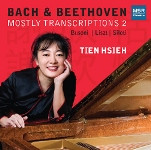|
Back
11/30/2014
Bach and Beethoven: “Mostly Transcriptions 2”
Johann Sebastian Bach: Prelude and Fugue in D major, “The Great”, BWV 532 - Chorale Prelude “Ich ruf’ zu dir, Herr Jesu Christ”, BWV 639/177 (arr. F. Busoni) - Prelude and Fugue in A minor, BWV 543/S. 462 (arr. F. Liszt) - “Adagio” from Sonata No 5 in F minor, BWV 1018 (arr. Alexander Siloti)
Ludwig van Beethoven: Piano Sonata No 32 in C minor, Opus 111 (arr. A. Siloti) - An die ferne Geliebte, Opus 98/S. 469 (arr. F. Liszt)
Tien Hsieh (piano)
Recording: Blue Wave Productions, Vancouver, BC, Canada (October 11-14, 2013) - 71' 13
MSR Classics #MS1531 – Booklet in English

   
Transcriptions for piano solo, especially those from Bach’s organ works, have generated greater interest in recent times. Once dismissed as meretricious virtuoso showpieces, they are now being studied on their own structural and artistic terms (and hopefully, merits), a perspective akin to evaluating, or re-evaluating movies adapted from classic novels and plays.
This new recording by the Chinese-American pianist, Tien Hsieh, offers several such works. It then concludes with Beethoven’s final, and arguably greatest and most demanding Piano Sonata, Opus 111, for which this young artist garnered high praise when she performed it in New York City a few years ago.
Unfortunately, the disc is almost entirely disappointing. Hsieh’s tone and approach to the keyboard are listless and sorely lacks imagination or personality of any kind. There is little variety of tone (not even much staccato, even when scores indicate it), and what’s more perplexing, very little dynamic variety. One would think that a digital recording using a 9-foot, 2-inch Fazioli concert grand (which is larger than even the biggest Steinway), done in controlled studio conditions with, presumably, the most modern gear available, would at least generate some kind of interesting, engaging or varied sound. Hearing this CD, listeners will wait in vain.
Most of this performer’s playing is at the kind of wide awake, mezzo-forte level one associates with pianists trained in the “dead weight” school of tone production which, according to its more dedicated proponents, means that arm weight must be used at all times. The problem with this approach to technique is that true pianissimos (as well as true fortissimos) are impossible, and the result is bland and boring. The opening Bach-Busoni Prelude and Fugue in D major sounds more like competent sight reading than any kind of considered interpretation or approach to the music, or any attempt to transcribe the sonic ambience of one instrument to another --- which most listeners will expect from a CD titled Mostly Transcriptions.
Compared to such pallid playing, the more contrived, showy and otherwise immature pianists one also often hears aren’t so bad after all. The reference which springs to mind for Hsieh’s Beethoven Sonata, Opus 111 would be Glenn Gould’s recording made about 60 years ago when Gould was in his early 20s. His tempi sometimes bordered on the insane, and not surprisingly, the LP was pilloried by most critics and commentators. However, whether or not people liked the performances, there was no question that this was a pianist who had strong ideas about the music and possessed the skills to communicate those ideas. There was much, even for the most academic, old-school pundits to ponder, even if they hated every note of it.
With Ms. Hsieh’s recording of this Beethoven, the rhythmic and tonal blandness, which (at least in the second movement’s “Arietta”) might somehow be mesmerizing and sustained, simply is dull. There is no sense of cadence or any other manifestation of tension, even when Beethoven’s writing telegraphs this from the opening notes of both movements (which both Chopin and Scriabin borrowed for some of their Sonatas).
The pianist also has little sense of even remotely subtle pedaling. Her pedaling is so random and ill-considered in terms of how pedals impact overall sonority. The result suggests a pre-teen whose feet have finally grown enough to reach them and is just beginning to learn how the sustaining pedal actually works.
Ms. Hsieh deserves genuine commendation for bringing less familiar repertoire to listeners. We can only hope she’ll have more to say about these works in future performances.
Charles Pope Jr.
|